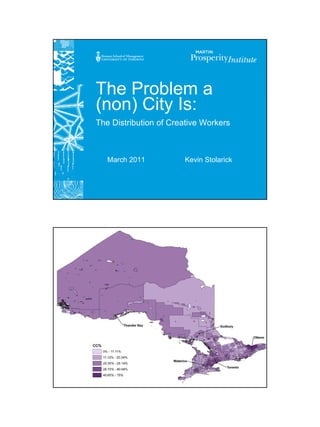
The Distribution of Creative Workers Across Cities, Counties and Regions
- 1. The Problem a (non) City Is: The Distribution of Creative Workers March 2011 Kevin Stolarick
- 2. US Metro Areas (Total Creative)
- 3. US Metro Areas (under 500,000) US Counties
- 4. US Counties (under 100,000) Ontario CSDs (over 100 creative)
- 5. Ontario CSDs (under 100,000) All Geographies (over 100 workers)
- 6. All Geographies (over 100) All Geographies (over 100) Above Upper?? Upper Bound?? Lower Bound??
- 7. Greatest Positive Residuals Los Alamos County, New Mexico 10,053 63.1% Arlington County, Virginia 134,321 60.0% Falls Church city, Virginia 5,969 59.4% District of Columbia, District of Columbia 321,466 54.3% Alexandria city, Virginia 88,771 53.3% Deep River (3547096) T 00000 1,905 52.8% New York County, New York 938,448 52.2% Fairfax County, Virginia 566,856 51.5% Howard County, Maryland 152,709 51.1% Loudoun County, Virginia 154,255 50.9% Montgomery County, Maryland 528,475 50.9% Fairfax city, Virginia 12,875 48.0% Durham, NC 274,720 46.9% Carter County, Montana 755 46.3% San Jose-Sunnyvale-Santa Clara, CA 888,480 46.1% Washington-Arlington-Alexandria, DC-VA-MD-WV 2,299,330 46.1% San Francisco County, California 474,594 46.1% Washington-Arlington-Alexandria, DC-VA-MD-WV 2,856,750 45.8% Albemarle County, Virginia 47,908 45.4% Ithaca, NY 49,860 45.2% Boulder, CO 155,400 44.8% Douglas County, Colorado 150,468 44.7% Middlesex County, Massachusetts 830,174 44.6% Framingham, MA 156,470 44.5% York County, Virginia 28,201 44.5% Bethesda-Gaithersburg-Frederick, MD 556,420 44.3% Marin County, California 131,550 44.2% Oakville (3524001) T 00000 91,130 44.1%
- 8. (Inverse) Distance Weighted Creative Class • Sum (for all CSDs) – Total CC ÷ distance away (km) • Gravity weighted • Total CC ÷ (distance away (km))2 Regressing Total Creative Class
- 9. Regressing Logged Creative Class Regressing Percent Creative Class
- 10. Regressing Total Creative Class - Gravity Regressing Logged Creative Class - Gravity
- 11. Regressing Percent Creative Class - Gravity Takeaways (for now) • Distributions are different – All (large) versus small (rural) regions • Strong, positive relationship – Region size (logged) and SHARE creative – Bigger regions higher share – Lower bound – steeper than average (faster) • Outside (above) the “schmeer” – (select) Urban Centres – University Towns (some) – Rural concentrations (meds/eds/law)
- 12. Takeaways (for now) • Creative Proximity - distance – Zilch, nada, nothing • Creative Proximity – gravity – Total Creative (not logged; share) • Region/Market Size – Consistent • Density – Not Really • Growth – Negative?